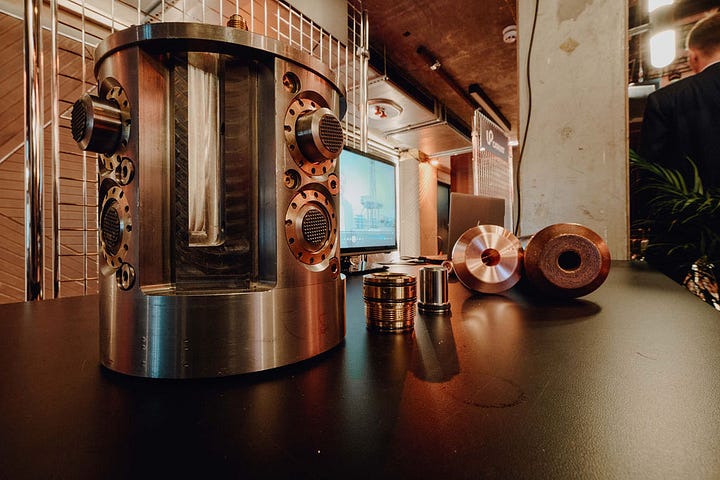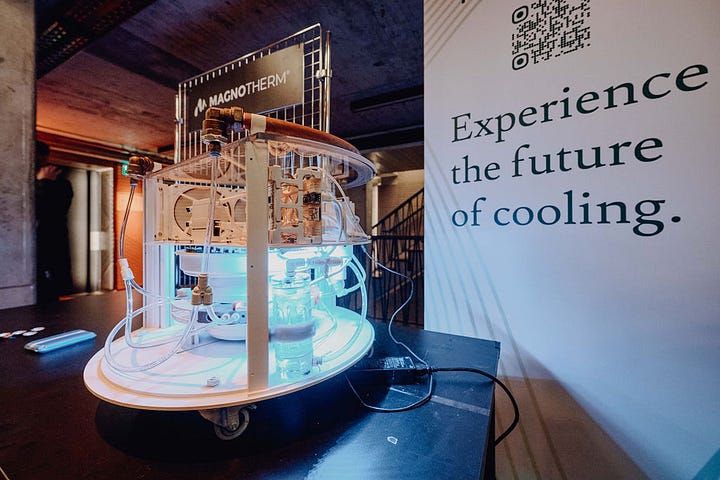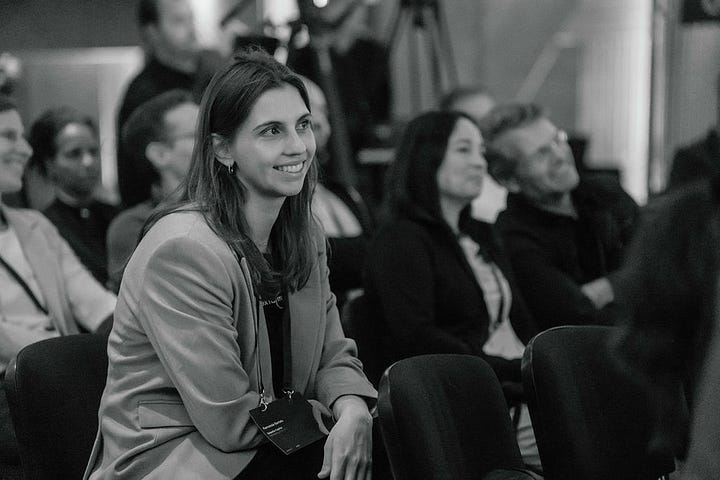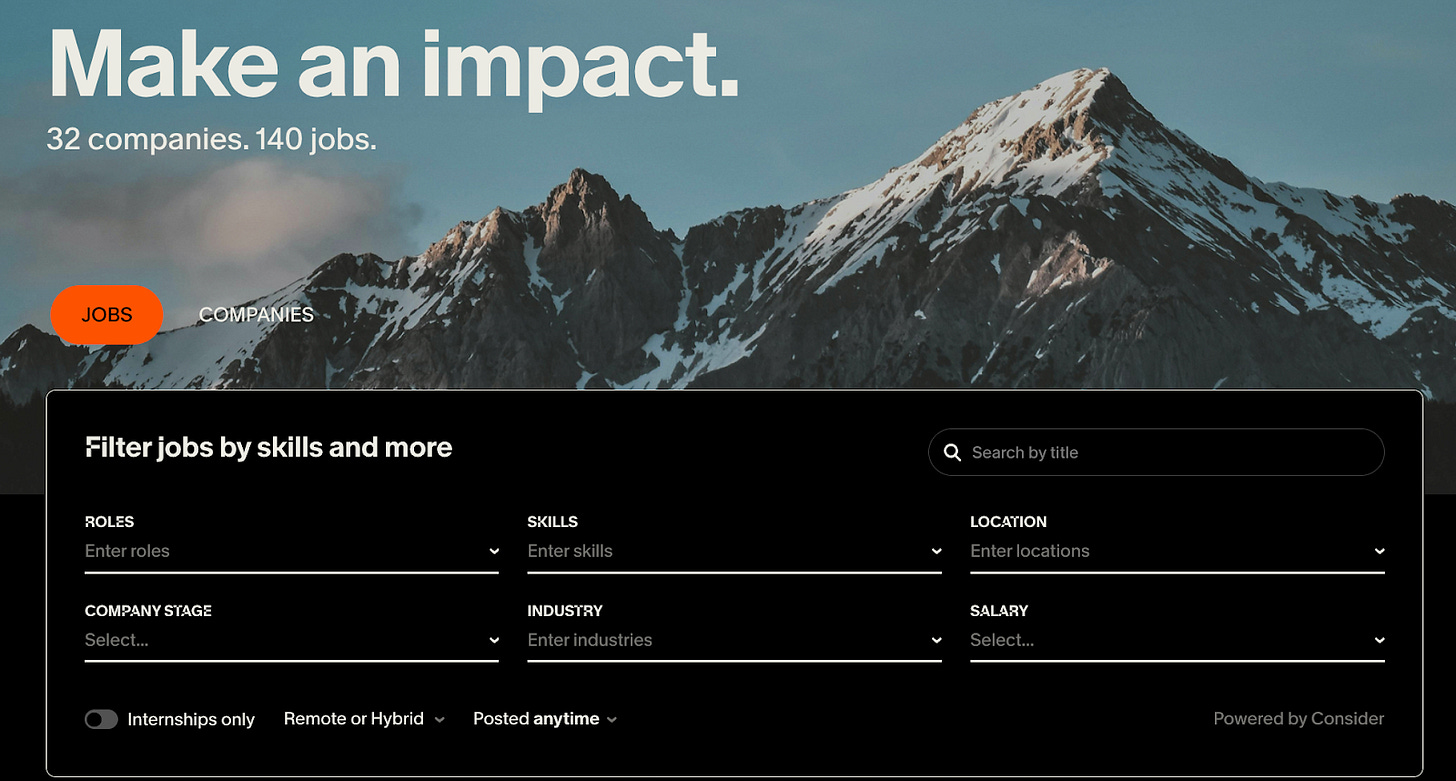The VC Comms Playbook #3 with Fernanda Bartels, Extantia
A masterclass in rebranding, organising unique AGMs that showcase hardware, and turning complex climate deeptech into stories that inspire action
Welcome back to The VC Comms Playbook! Coming back strong after a summer hiatus and the madness of September, you’re in for a real treat with this latest edition.
First off, I wanted to say a big thank you to everyone who has been following along. We’re already 125+ subscribers strong, with comms leads from funds all over the world, not to mention those who read but haven’t subscribed (yet), and all those who follow along on LinkedIn.
Your feedback and encouragement after the first two editions (with Ellie from Earlybird and Michelle from redalpine) has been invaluable, and I am so excited to keep on building this series with you.
For Edition #3, we’re diving into one of my favourite areas: ClimateTech. I’m excited to introduce you to Fernanda Bartels, the Marketing Director at Extantia, one of Europe’s pioneering climate-first funds. Her super-lean team consists of just herself and a marketing student, supported by trusted external partners. Since joining in 2022, she has led a major rebrand, built a distinctive voice, and continuously helps portfolio founders grow by translating complex climate technologies into simple, powerful and engaging stories.
One of my favourite aspects of this interview relates to something every VC comms person knows all too well: the special challenge of organising an engaging, smoothly-run and unique AGM. Fernanda takes the planning and logistics skills needed to organise the AGM to the next level, as the mastermind behind Extantia’s truly unforgettable AGMs. Stay tuned…
As always, we’ll start with the basics:
Extantia:
Year founded: 2020
Purpose: Backing pioneers in climate tech; leveraging capital as a driver for decarbonisation.
Focus areas: Software and hardware solutions that address large, near-term market opportunities with the power to redefine industries. Sectors include renewable energy, industrial decarbonisation, carbon removal, buildings, mobility, and materials innovation
AuM: €204M flagship fund (final close in 2024)
Significant investments: Reverion, Ineratec, Modern Synthesis, Vema Hydrogen, Epoch Biodesign, AssetCool, Phlair, MAGNOTHERM
Extantia also has a fund of funds. Fund commitments incl. Lowercarbon Capital, Astanor, 2150, Counteract, and moreInternal events for LPs and portfolio companies: AGM and DREAM (Extantia CEO Summit)
External events: Slush Climate Summit (an official Slush side event), and many other side events throughout the year (published in the Extantia Luma events calendar)
Ecosystem events: Extantia Partner Sebastian is a founding and board member of Super Climate.
Exit metrics: 23 exits and acquisitions (e.g., Araris, Enviria, Lunaphore, Insphero, Natif.ai and more)
VC Comms Playbook Edition #3: INVESTING IN PIONEERS FINDING NEW PATHS TO UNLOCK GROWTH FOR GOOD: For a faster, cheaper and more sustainable future.
Fernanda and I have always had interesting conversations, but when we met for lunch in Berlin to discuss this interview, we both didn’t quite expect just how deep we would go in our conversation. Originally recorded across two sessions since we had too much to discuss, I’ve done my best to reduce our conversation to its essence.
(Editor’s Note: If you follow me on LinkedIn, you’ll see that I’ve done something new for the “TLDR version” on LinkedIn - I’ve summarised key takeaways in the style of my favourite Axios “Smart Brevity” framework. I’d appreciate feedback on whether you’d like to also see this summary in the Substack post with links to the sections in question, or if you want to just join along for the fully written-out ride)
Walk me through the communications and marketing setup at your fund. Who does what? What gets outsourced? Include things like design, events, or platform/portfolio support
Like many others, we run a lean team, just myself plus a marketing student. For design, we continue to work with the agency that led our rebrand. PR is split between a German agency plus a boutique firm for English-speaking markets (US/UK). Creating high-quality, technical and educational content is central to our work, so I also collaborate with a technical writer when deep STEM expertise is needed.Portfolio support varies depending on the maturity of the company. Some startups already have their own comms leads, while others need more hands-on guidance, especially for first announcements.
Events are another very important pillar. We handle the day-to-day logistics in-house, but we bring in specialists, like producers, photographers, videographers, runners etc., for big moments like our AGM and DREAM.
Tell me about your AGM. I know it’s not your typical investor get-together….
It’s definitely a logistical feat, especially the portfolio showcase with so many hardware companies. Last year, startups brought everything from e-fuel bottles to ultra-deep geothermal drilling bits, wind turbine crawling robots, magnetocaloric refrigeration systems, and even a power plant. So, coordinating shipping and display was no small task. One of the trickiest (but also most fun) parts is working with the event producer to figure out how to present these innovations, and then actually getting them to the venue safely and on time.




Wow, that’s impressive. It reminds me of my side gigs alongside freelancing, in my pre-PIABO days, working on film and photoshoot sets. Or stories of friends in the art world who have to coordinate insured shipping of giant sculptures and installations for art fairs like Frieze or Art Basel.
Yes, exactly, it really can get quite tricky. We went back and forth on questions like: Do we build a structure from scratch? How should we arrange everything? And then, of course, not all the hardware is exhibition-friendly. To make it even harder, none of them were Berlin-based, so just getting everything to the venue was the toughest part of last year’s AGM. But honestly, that’s also what makes it worth it.
One of the toughest parts of Climate- and DeepTech comms is translating complexity into everyday language. Founders often get stuck in technical detail. How do you handle that at Extantia?
Absolutely. We spend a lot of time helping founders make their work clear to people without technical backgrounds.
Many members of our investment team do have scientific or highly technical backgrounds, which works fine internally, but when it comes to external communications, investors also need to be able to explain things to all audiences.
To me, it’s not just about simplifying things, it’s about creating real storytelling, bridging the knowledge gap and making the science engaging, so anyone can connect with it. That’s the real test of whether a story truly lands.
I feel like we could keep going on this forever, but let’s zoom out. Some funds prefer to fly under the radar, while others, like Extantia, have chosen to build a strong brand presence. Why that approach? And what is unique about climate tech branding and comms?
When we launched, “climate tech” was still misunderstood. Most people thought only of EVs. As pioneers, we felt responsible for educating the market: showing where capital should flow, highlighting breakthrough technologies, and sparking urgency around climate action. A big part of this meant bringing people together in person and doing this groundwork together with other funds.
One example of collaboration in climate tech is Super Climate, which has now become one of the most sought-after climate events. It began as a joint initiative in 2021 between Sebastian (Extantia), Nick (Planet A), and Otto (Revent). In 2023, I led the initiative, organizing three events in Berlin, New York, and Dubai (COP28). The momentum led the founders (now board) to hire Rafael to grow it into a standalone entity, where I am a founding member. Last year, they hosted five sold-out events, and this year, they are on track to host six.
As the industry and our fund matured, our rebranding was another key step. It wasn’t a reinvention, but an alignment. We needed a design and a voice that matched our ambition and personality. The process involved all partners, senior team members, and countless iterations. Finding the right designer, someone who understood climate, VCs, and our ethos, was crucial. We chose based on experience, creative fit, and especially chemistry. The result is a brand we all identify with. It took a big chunk of my time last year, but I’m genuinely proud of it.
How do you generally involve the team for comms and ensure you get buy-in for decisions?
I usually work most closely with Sebastian and Yair. Sebastian has marketing experience, and Yair is a natural storyteller. But everyone in the team wears a “marketing hat.” I think this is super important.
Some GPs write, others are great speakers and shine at events or are superstar networkers. My role is to lean into each person’s natural strengths while keeping us consistent. With the rebrand, we involved everyone through workshops and open debates. This really helped us create a joint sense of ownership and enabled us to reach consensus without losing our focus.
7. How did you involve the Partners and other stakeholders in the rebrand?
With the rebrand, I also worked most closely with Sebastian and Yair, but we involved the full team when it mattered. We held a workshop with Yannick (zur Strassen), who led the project, and he interviewed all the senior team members. That surfaced common threads and gave people a sense of ownership, which made it much easier to get buy-in later on.
Once we had a first draft, Yannick presented it to the full team, and we opened it up for debate. Branding debates can get lively, sometimes even around something as simple as preferring the colour blue versus green! The key is filtering through. From the start, it was clear that while everyone has opinions, what we need are qualified ones.
That’s the fine line in comms: listen and acknowledge, but also stand firm on the core principles. You can’t fight every battle, but you can’t compromise on what really matters either. In the end, it’s most effective to get buy-in as you go along. When you involve people in the process, they are more likely to be happy with the results. I am proud to say that we achieved that with our rebrand.
8. Tell me about one of your proudest moments or biggest lessons learned in your career so far.
Excellent organisation truly pays off. Last year, despite the insane hardware logistics that I mentioned, I left the AGM venue by 7pm the night before. That’s how smooth we’d made it. But if you’re not organised, the opposite happens and it can really become a nightmare.
Another example is our CEO Summit, which took place in Mallorca last June, right in the middle of high season. The real challenge again was logistics, moving guests from the airport to the hotel and then to the summit itself.
On the PR side, we’ve been lucky enough to work with journalists who can balance great founder storytelling with deep dives into the companies’ technology. Of course, as the companies grow, they receive more inbound interest and get on the radar of the wider media, and benefit from working with their own PR and communications agency and/or in-house person.
9. Do you find that because Extantia by now is an established name in the climate space, there’s a natural curiosity whenever you’re involved?
Being established definitely helps. That’s really the goal, you want your fund’s investment to act like a stamp of approval. It works for both investors and media: when they see a certain fund name backing a company, the reaction should be, “Okay, I’m paying attention.”
That’s what brand-building is all about: giving our portfolio companies that quality stamp. If we can elevate them in that way, it makes everything easier, whether they’re hiring talent or raising their next round.
10. Let’s talk about the evolving media landscape. How do you see it shifting, paid vs. earned, newsletters, owned channels? And what about personal branding?
They’re all connected. Back when I was at journalism school, my sports journalism professor asked: why aim to write for The New York Times if you could write for your favourite sports team and tell their story directly? This shift started long ago, towards brands owning their narratives.
Venture has followed the same path. VCs don’t just invest any more, they’re starting to behave like media houses. And it makes sense, because if you want access to the best deals, deliver returns to LPs, and give portfolio companies a platform, building your own audience isn’t a nice-to-have. It’s essential.
Paid has its place in things like event sponsorships, boosting things that aren’t real news. But for thought leadership and trust-building, earned media is stronger. Nowadays, “earned” is broad: podcasts, newsletters, influencer communities. I see ‘earned’ as a way of reaching an audience that isn’t familiar with you yet – the platform where you find this audience certainly varies.
Owned channels matter too. For us, LinkedIn is key: grow your audience there and all your target audiences notice, your network, and also journalists. It’s a loop.Personal branding fits in here, too. Each GP has different strengths, be it writing, speaking, or networking. My task here is to help them show up authentically while staying aligned with Extantia’s core message.
For founders, we always push them to hire marketing people early. It’s fundamental to sales and fundraising.
11. What’s your current comms tech stack, and how is it evolving? Consider things like: if you’ve built proprietary platform tools or when and where you’re using AI.
We keep it pretty straightforward. Company-wide, we use Google Workspace for email, docs, and presentations, plus Slack and Notion. In Notion, we even built small integrations, like monitoring LinkedIn influencers to track conversations on certain topics.
For design, we rely on Canva for day-to-day templates, while our designer handles bigger projects. We’ve used Figma, and for simple video edits I’ll just use iMovie.
For events, we use Cvent for large, complex gatherings like the AGM or CEO Summit as it lets us create custom registration paths and landing pages, and for smaller events, we use Luma.
Marketing runs on Mailchimp for newsletters, Webflow for the website, and Zapier for integrations.
In terms of AI, we use ChatGPT and similar tools to support us with content. The investment team works with Affinity as their CRM, and its built-in AI note-taker is surprisingly good, much smoother than some of the other tools out there.
We also use Consider, a job portal tool, to share open roles across our portfolio. That powers the job portal on our careers page.
12. If you had an unlimited budget and no operational constraints, what communications or brand experiment would you run?
I’d go all-in on guerrilla marketing: unexpected interventions that spark buzz and curiosity. At a gathering like New York Climate Week, imagine placing something odd or thought-provoking in a busy street, filming it, and starting a conversation online and offline.
I’d also lean into art. Branding and art intersect in powerful ways because they catch people off guard and invite curiosity. A storefront installation that makes people stop and wonder, what is this?, can pull them in emotionally before connecting them to the deeper climate story.
13. What’s something you used to believe early in your career that you now think differently about?
I used to think the work was all creative and “fun.” In reality, the admin, politics, and logistics are just as important, they make the creative side possible. The glossy final product is just the tip of a very big iceberg.
14. What’s a piece of communications advice you find yourself giving to founders or your GPs over and over again?
Keep it simple. Complexity might be accurate, but simplicity makes the story stick.
15. Who do you admire most in the communications world, inside or outside of venture? And who should I interview next?
I think it’s important to draw inspiration from outside our bubble, but also to learn from our peers pushing the boundaries within VC.
Art and sports are big sources of inspiration for me. Both use storytelling and emotion in ways we can borrow from. Even how a game is staged, or how an exhibition is lit, can spark ideas.
Within VC, I’d recommend Kasey from HV Capital, Ellie from Earlybird (who you’ve already spoken to), Lena from First Momentum, Pauline from KOMPAS VC, and Heba from Serena, who all bring really valuable perspectives.



